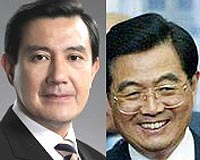 |
Taipei, Taiwan (UPI) Mar 10, 2011 Taiwan plans to reduce its troop levels by 9,200 this year as part of a five-year plan to cut back by 60,000 personnel, a 20 percent reduction. But Taipei will continue to purchase more advanced high-tech weaponry to ensure it maintains a suitable defense capability, the Ministry of National Defense said. The troop cuts will leave a force of around 215,000 by the end of the year as the country moves toward an all-volunteer army by 2014, a pledge made by President Ma Ying-jeou in his 2008 election campaign. "The era of maintaining huge numbers of armed forces has gone," a Defense Ministry spokesman said. "Defense capability is no longer determined by the number of troops." But a strong arsenal is essential for self-defense at the same time as pushing for bilateral talks with China, he said. Ma also pledged in 2008 that the military budget would be at least 3 percent of gross domestic product, something opposition parties claim isn't happening and in the face of recent a large Chinese military budget increase. Earlier this month China -- which lies 100 miles across the Strait of Taiwan -- boosted its defense budget by 12.7 percent for 2011, rising to $91.5 billion. This compares to a 7.5 percent increase in 2010 and amounts to 6 percent of the Chinese national budget for 2011. The large increase in China's defense budget has led analysts to say they fear an arms race among Asian nations, not least Taiwan whose defense policy of a strong military has been a cornerstone of its existence since 1949. Only with a strong military can Taiwan guard its independence from the Beijing government that has, since the communist victory in the civil war in 1949, claimed Taiwan as a province. Despite Taiwan's separate government and democratic processes, Beijing has insisted on its "one-China" policy whereby it puts political pressure on many countries -- including the United States -- to acknowledge Beijing's claim to Taiwan. At the top of Taiwan's military shopping list is the purchase of more than 65 advanced General Dynamics F-16 fighter from the United States, much to the annoyance of China. In 2010 China froze its military contacts with the United States over U.S. arms sales to Taiwan, although military relations have improved since the beginning of this year. But in early January, China confirmed the first test flight of its highly controversial prototype J-20 stealth fighter, ending speculation that the secretive aircraft had taken to the air. China has been guarded about details, specifications and development progress of the aircraft that is similar in profile to Lockheed Martin's F-22 Raptor stealth fighter. The J-20 is believed to be larger than the F-22 -- the only truly stealth fighter operational -- or Russia's prototype stealth fighter, the Sukhoi T-50, which had its first test flight in January 2010 and is expected in service sometime after 2015. Taiwan wants to buy Patriot missiles, which target incoming short- and medium-range ballistic missiles. Within the region last week, Japan announced plans to purchase Patriot PAC3 interceptors. Japan will also increase its work on Aegis, the U.S.-led sea-based system to protect ships and troops from ballistic missiles, in particular, the DF-41 missile that China is developing. The DF-41 is believed capable of carrying multiple independently targeted warheads. With military preparedness a high priority for Taiwan, January's missile test failures were keenly felt by Taipei. Ma said he was disappointed with the results of the major air defense missile test at a base in Pingtung County and in which six of the missiles failed to find their targets. "I'm not satisfied with the results," Ma said. "I hope the military will determine the reasons and improve its training." Ma, along with reporters, watched the tests from a building overlooking the Chungshan Institute of Science and Technology's Jiupeng missile testing base. The tests included Sky Bow IIs missiles, MIM-23 Hawks and FIM-92 Stingers. Four of the six missile malfunctions included a failure to detonate. One of the RIM-7M Sparrow missiles reportedly climbed to around 600 feet but 30 seconds after launch veered wildly off course and plunged into the South China Sea. The missile tests were part of a larger air defense drill including Taiwanese military's General Dynamics F-16A/B, Mirage 2000, Northrop F-5E/F, the Ching-kuo Indigenous Defense Fighter aircraft as well as a Bell AH-1W Cobra attack helicopter.
Share This Article With Planet Earth
Related Links Taiwan News at SinoDaily.com
 Taiwan's leader denies falling into China 'trap'
Taiwan's leader denies falling into China 'trap'Taipei (AFP) March 8, 2011 Taiwan's President Ma Ying-jeou has rejected criticism that he has fallen into Beijing's "trap" and vowed to press on with a controversial policy of greater economic integration with the Chinese mainland. In an interview with the Financial Times, Ma dismissed allegations from the Taiwanese opposition that in exchange for trade sweeteners, Beijing will extract political concessions, aiming to ... read more |
|
| The content herein, unless otherwise known to be public domain, are Copyright 1995-2010 - SpaceDaily. AFP and UPI Wire Stories are copyright Agence France-Presse and United Press International. ESA Portal Reports are copyright European Space Agency. All NASA sourced material is public domain. Additional copyrights may apply in whole or part to other bona fide parties. Advertising does not imply endorsement,agreement or approval of any opinions, statements or information provided by SpaceDaily on any Web page published or hosted by SpaceDaily. Privacy Statement |